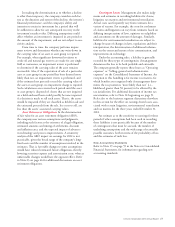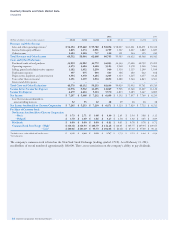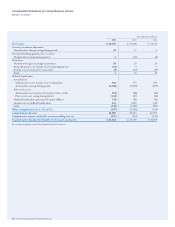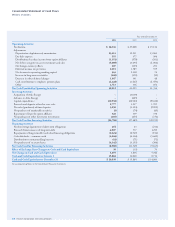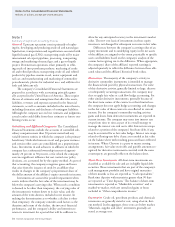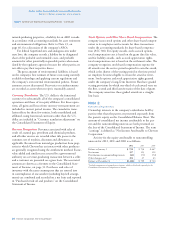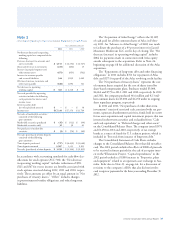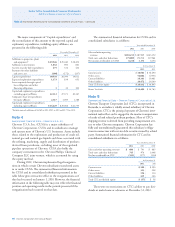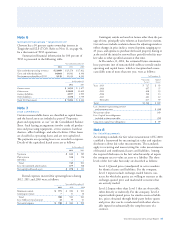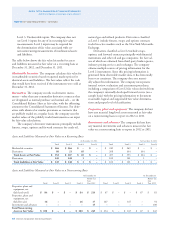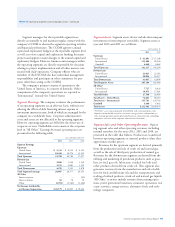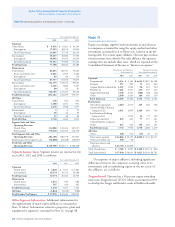Chevron 2012 Annual Report Download - page 38
Download and view the complete annual report
Please find page 38 of the 2012 Chevron annual report below. You can navigate through the pages in the report by either clicking on the pages listed below, or by using the keyword search tool below to find specific information within the annual report.
36 Chevron Corporation 2012 Annual Report
Note 1
Summary of Significant Accounting Policies
General Upstream operations consist primarily of explor-
ing for, developing and producing crude oil and natural gas;
liquefaction, transportation and regasication associated with
liqueed natural gas (LNG); transporting crude oil by major
international oil export pipelines; processing, transporting,
storage and marketing of natural gas; and a gas-to-liquids
project. Downstream operations relate primarily to ren-
ing crude oil into petroleum products; marketing of crude
oil and rened products; transporting crude oil and rened
products by pipeline, marine vessel, motor equipment and
rail car; and manufacturing and marketing of commodity
petrochemicals, plastics for industrial uses, and additives for
fuels and lubricant oils.
e company’s Consolidated Financial Statements are
prepared in accordance with accounting principles gener-
ally accepted in the United States of America. ese require
the use of estimates and assumptions that aect the assets,
liabilities, revenues and expenses reported in the nancial
statements, as well as amounts included in the notes thereto,
including discussion and disclosure of contingent liabilities.
Although the company uses its best estimates and judgments,
actual results could dier from these estimates as future con-
rming events occur.
Subsidiary and Affiliated Companies e Consolidated
Financial Statements include the accounts of controlled sub-
sidiary companies more than 50 percent-owned and any
variable-interest entities in which the company is the primary
beneciary. Undivided interests in oil and gas joint ventures
and certain other assets are consolidated on a proportionate
basis. Investments in and advances to aliates in which the
company has a substantial ownership interest of approxi-
mately 20 percent to 50 percent, or for which the company
exercises signicant inuence but not control over policy
decisions, are accounted for by the equity method. As part of
that accounting, the company recognizes gains and losses
that arise from the issuance of stock by an aliate that
results in changes in thecompany’s proportionate share of
the dollar amount of the aliate’s equity currently in income.
Investments are assessed for possible impairment when
events indicate that the fair value of the investment may be
below the company’s carrying value. When such a condition
is deemed to be other than temporary, the carrying value of
the investment is written down to its fair value, and the
amount of the write-down is included in net income. In
making the determination as to whether a decline is other
than temporary, the company considers such factors as the
duration and extent of the decline, the investee’s nancial
performance, and the company’s ability and intention to
retain its investment for a period that will be sucient to
allow for any anticipated recovery in the investment’s market
value. e new cost basis of investments in these equity
investees is not changed for subsequent recoveries in fair value.
Dierences between the company’s carrying value of an
equity investment and its underlying equity in the net assets
of the aliate are assigned to the extent practicable to specic
assets and liabilities based on the company’s analysis of the
various factors giving rise to the dierence. When appro priate,
the company’s share of the aliate’s reported earnings is
adjusted quarterly to reect the dierence between these allo-
cated values and the aliate’s historical book values.
Derivatives e majority of the company’s activity in
derivative commodity instruments is intended to manage
the nancial risk posed by physical transactions. For some
of this derivative activity, generally limited to large, discrete
or infrequently occurring transactions, the company may
elect to apply fair value or cash ow hedge accounting. For
other similar derivative instruments, generally because of
the short-term nature of the contracts or their limited use,
the company does not apply hedge accounting, and changes
in the fair value of those contracts are reected in current
income. For the company’s commodity trading activity,
gains and losses from derivative instruments are reported in
current income. e company may enter into interest rate
swaps from time to time as part of its overall strategy to
manage the interest rate risk on its debt. Interest rate swaps
related to a portion of the company’s xed-rate debt, if any,
may be accounted for as fair value hedges. Interest rate swaps
related to oating-rate debt, if any, are recorded at fair value
on the balance sheet with resulting gains and losses reected
in income. Where Chevron is a party to master netting
arrangements, fair value receivable and payable amounts rec-
ognized for derivative instruments executed with the same
counterparty are generally oset on the balance sheet.
Short-Term Investments All short-term investments are
classied as available for sale and are in highly liquid debt
securities. ose investments that are part of the company’s
cash management portfolio and have original maturities
of three months or less are reported as “Cash equivalents.”
Bank time deposits with maturities greater than 90 days
are reported as “Time deposits.” e balance of short-term
investments is reported as “Marketable securities” and is
marked-to-market, with any unrealized gains or losses
included in “Other comprehensive income.”
Inventories Crude oil, petroleum products and chemicals
inventories aregenerally stated at cost, using a last-in, rst-
out method. In the aggregate, these costs are below market.
“Materials, supplies and other” inventories generally are
stated at average cost.
Notes to the Consolidated Financial Statements
Millions of dollars, except per-share amounts



